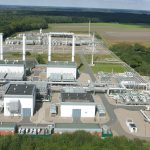Introduction
Underground gas storing is, principally, injecting gas into underground, natural, or artificial storing facilities and producing this gas back when needed.
Objectives
The main objective of storing the gas underground is to provide a sustainable source of energy when prices are fluctuating due to natural crises (such as hurricanes, earthquakes, etc.) or political crises around the world. So, storing gas of suitable quantities is considered a crucial part of the country’s national security.
Definitions:
- Total gas storage capacity: It is the maximum volume of natural gas that can be stored at the storage facility. It is determined by several physical factors such as the reservoir volume, and on the operating procedures and engineering methods used.
- Total gas in storage: It is the total volume of gas in storage at the facility at a time.
- Base gas (also referred to as cushion gas): It is the volume of gas that is intended as permanent inventory in a storage reservoir to maintain adequate pressure and deliverability rates throughout the withdrawal season.
- Working gas capacity: It is the total gas storage capacity minus the base gas.
- Working gas: It is the total gas in storage minus the base gas. Working gas is the volume of gas available to the marketplace at a time.
- Physically unrecoverable gas: The amount of gas that becomes permanently embedded in the formation of the storage facility and that can never be extracted.
- Cycling rate: It is the average number of times a reservoir’s working gas volume can be turned over during a specific period. Typically, the period used is one year.
- Deliverability: It is a measure of the amount of gas that can be delivered (withdrawn) from a storage facility daily. It is also referred to as the deliverability rate, withdrawal rate, or withdrawal capacity and is usually expressed in terms of millions of cubic feet of gas per day that can be delivered.
- Injection capacity (or rate): It is the amount of gas that can be injected into a storage facility daily. It can be thought of as the complement of the deliverability. Injection rate is also typically measured in millions of cubic feet of gas that can be delivered per day.
Distribution around the world
The following diagram (Figure-2) shows four main factors that express the underground storage and the contribution of different countries into these factors:
- Number of facilities around the world: 672.
- Working gas capacity: the gas that can really be withdrawn and used.

Figure-1
- Maximum withdrawal rate:
- Cushion gas capacity: the percentage of gas that will remain in the storing facilities.

Figure-2: Global underground gas storage as of end 2016 – by region
- From the diagram above we can see the total number of facilities (672), where USA and Europe occupy the top two contributors.
- While the second chart shows the maximum daily withdrawal gas capacity of 7,126 Million of cubic meters per day.
- In the 3rd chart, the total working gas (that can be withdrawn) is 424 Billion of cubic meters.
- The last chart shows the cushion gas capacity (residual) that remains in the storage; 398 Billion of cubic meters.
Historical evolution:
Working gas capacity has increased significantly since 2010 as shown in Figur-2

Figure 3: Evolution of global working gas capacity, 1970 -2016
Types of storages:
- Depleted gas reservoirs
- Aquifer Reservoir
- Salt formation
In this article we will talk about the Depleted Gas Reservoir, other types will be in a separate article.
Depleted gas reservoirs
Depleted reservoirs are attractive because their geological and physical characteristics have already been investigated by geoscientists are usually well-known. Oil and gas fields that have already been more or less fully exploited are particularly suitable for the underground storage of natural gas. As these structures have successfully kept their hydrocarbon deposits trapped for millions of years, they have already demonstrated their geological suitability for storage purposes. No special exploration is required for this kind of storage and, as an additional advantage, any existing exploitation wells can potentially be re-used for gas injection and gas withdrawal The gas stored in this type of facility is injected under a pressure that is higher than the actual reservoir pressure ,so that, when there is an increase in demand for gas, it can be withdrawn by expansion.

Figure-2 Depleted Reservoir Gas Storage
The gas turnover rates that can be achieved from such reservoirs are dependent on the dimensions and design of the original exploitation wells and on the properties of the reservoir. To increase gas turnover rates, especially in thin rock layers, new wells are increasingly being drilled in such a way that the lower section of the well runs horizontally along the storage formation. This provides a considerably larger flow area for the gas along with significantly higher injection and withdrawal rates. When depleted fields are used for natural gas storage, the possibility of any residual gases mixing with the injected gas cannot be excluded. Measures for avoiding quality problems (e.g. by increasing the cushion gas volume of storage gas) may have to be considered, depending on the differences in composition of any residual gas and the storage gas. This is also why gas processing plants are sometimes installed at the surface to guarantee that the gas re-injected into the pipeline has the same quality as the pipeline gas. Geologically, it is preferred that depleted reservoir formations have high porosity and permeability. The porosity of the formation is one of the factors that determines the amount of natural gas the reservoir can hold. Permeability is a measure of the rate at which natural gas flows through the formation and ultimately determines the rate of injection and withdrawal of gas from storage.
Salt formation
This type of facilities represents XX% of total types of underground gas storage facilities around the world. To construct what is called caverns, which will be used to store gas underground, a salt dome of good properties from rock mechanics point of view and good solubility is required in addition to other geological circumstances such as the presence of a cap rock and a geological stability.
En. Kalaf Sliman
 AZİMUTHCOMP
AZİMUTHCOMP


